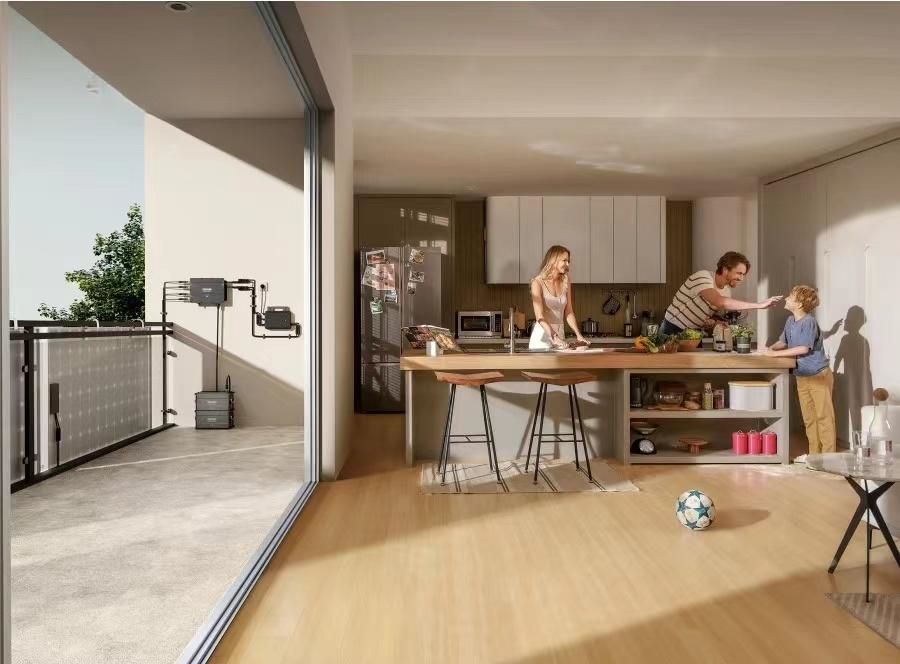Balcony Solar Energy Systems
Balcony Solar Energy Systems: Harnessing Clean Power in Urban Spaces

As society develops, the demand for energy continues to rise. Traditional resources such as coal and oil, which humanity has relied on, are being depleted rapidly, leading to increasingly severe environmental issues due to their combustion. Consequently, countries worldwide have shifted their focus towards seeking new clean energy sources to sustainably meet their energy needs. Among renewable and green energy sources, solar energy has garnered significant attention due to its abundant availability, cleanliness, and geographical flexibility. Solar photovoltaic (PV) panels have emerged as a primary method for harnessing solar energy. Countries across the globe are increasingly investing in large-scale ground-mounted solar farms, and the installation of small-scale residential and industrial rooftop solar PV systems is also on the rise.
Solar Energy Systems and Their Components
A solar energy system typically consists of several key components:
Solar Panels (Photovoltaic Panels): These panels are composed of solar cells that convert sunlight into electricity through the photovoltaic effect. They are the primary component responsible for capturing solar energy.
Inverter: The inverter converts the direct current (DC) electricity generated by the solar panels into alternating current (AC) electricity, which is used to power electrical appliances and devices in homes and businesses.
Battery Storage: Battery storage systems store excess electricity generated by the solar panels during periods of high sunlight for later use when sunlight is not available, such as during nighttime or cloudy days.
Charge Controller: The charge controller regulates the flow of electricity between the solar panels and the battery storage system, ensuring that the batteries are charged safely and efficiently.
Mounting Structure: The mounting structure provides support for the solar panels and ensures that they are securely installed on rooftops or other surfaces to maximize sunlight exposure.
Applications of Solar Energy Systems in Balconies
With the increasing population and limited land resources in many urban areas, high-rise residential buildings have become more prevalent. In such buildings, the installation of solar PV panels on balconies has gained widespread popularity, particularly for powering hot water systems. Balcony-mounted solar PV panels offer a space-efficient solution for harnessing solar energy in densely populated urban environments. Additionally, they contribute to reducing reliance on grid electricity and lowering electricity bills for residents.
Advantages and Disadvantages of Balcony Energy Storage
Advantages:
Space Utilization: Balcony energy storage systems optimize space utilization in urban environments where land availability is limited. By utilizing balcony space, residents can generate and store clean energy without occupying additional land.
Energy Independence: Balcony energy storage systems contribute to energy independence by reducing reliance on the grid. Stored solar energy can be used during periods of high electricity demand or grid outages, providing residents with a reliable source of power.
Cost Savings: By generating and storing their electricity, residents can reduce their electricity bills over time. Balcony energy storage systems offer long-term cost savings by offsetting the need to purchase electricity from the grid.
Environmental Benefits: Balcony energy storage systems reduce greenhouse gas emissions and air pollution associated with traditional energy sources. By utilizing clean, renewable solar energy, residents can lower their carbon footprint and contribute to a cleaner environment.
Disadvantages:
Risk of Damage: Balcony-mounted solar panels and energy storage systems are susceptible to damage during extreme weather events, such as strong winds or hailstorms. Damage to solar panels or batteries can result in costly repairs or replacements.
Aesthetic Impact: Some residents may find the installation of solar panels and energy storage systems on balconies aesthetically unappealing, particularly in residential buildings where visual uniformity is desired. Balcony energy storage systems may alter the appearance of the building facade and impact its overall aesthetic.
Maintenance Requirements: Balcony energy storage systems require regular maintenance to ensure optimal performance and longevity. Maintenance tasks may include cleaning solar panels, inspecting batteries, and checking electrical connections. Failure to maintain the system properly can lead to reduced efficiency and potential safety hazards.
Regulatory Challenges: Depending on local regulations and building codes, the installation of balcony energy storage systems may face regulatory hurdles or permit requirements. Residents may encounter challenges obtaining approval for system installation, which can delay implementation and increase costs.
While balcony energy storage systems offer numerous advantages, including space utilization, energy independence, cost savings, and environmental benefits, they also pose certain disadvantages, such as the risk of damage, aesthetic impact, maintenance requirements, and regulatory challenges. It is essential for residents and building owners to carefully consider these factors when planning the installation of balcony energy storage systems and to implement proper mitigation measures to address potential risks and challenges.
If you're interested in learning more about our solar energy storage offerings, we encourage you to explore our product line. We offer a range of panels and battery that are designed for various applications and budgets, so you're sure to find the right solution for your needs.
Website:www.fgreenpv.com
Email:Info@fgreenpv.com
WhatsApp:+86 17311228539













